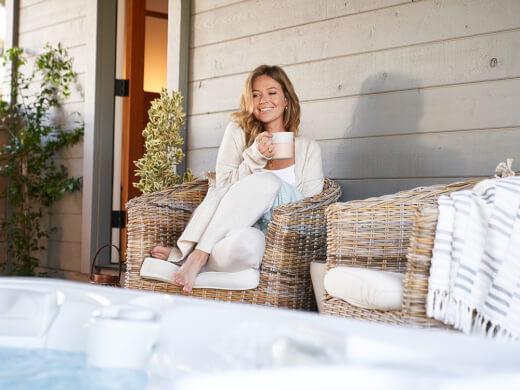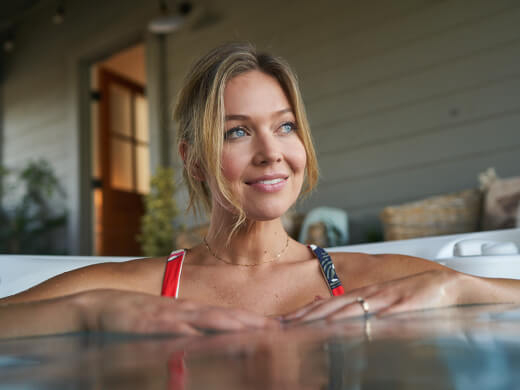How Can I Protect My Skin This Summer?
Learning about sunscreen and applying it properly is one example of a small change that can positively affect your well-being. Spending time in your hot tub is another; it's part of a holistic approach to wellness with significant benefits. Just 20 minutes a day in your own personal spa retreat can help you reduce stress, increase flexibility, help increase circulation, promote muscle recovery and improve sleep.
It's summer-the time of year when we're all exposed to more sunlight. We know by now that we should wear sunscreen when spending time in the sunny outdoors. But many of us don't realize that sun protection is a year-round activity if we truly want to avoid potential skin damage.

When soaking in your hot tub consider a spa side umbrella to protect your skin.
Armed with a bit more knowledge and just a few minutes of effort each day, you can make positive changes that can protect your skin from unnecessary aging and reduce the risk of skin cancer.
How does sunlight causes skin damage?
According to an article published on the Mayo Clinic website, there are two different Ultraviolet wavelengths that damage the skin with different effects:
1) UV-B is associated with sunburns.
2) UV-A is associated with skin aging.

Consider using your hot tub in the early mornings or evenings to avoid direct sun exposure.
Can you get skin cancer from one really bad sunburn?
Apparently this question gets asked a lot on the Internet. The answer depends on the frequency. If you have never been over-exposed to the sun and you get a bad sunburn then perhaps there is little damage done. The reality though is that you don't need a sunburn to get skin cancer. According to the American Society for Dermatologic Surgery (ASDS), people with fair skin can get skin cancer with minimal sun exposure.

In the summer the Earth tilts towards the sun and the sunlight hits at a more direct angle.
What are the aging effects of ultraviolet sunlight?
WebMD.com states that unprotected skin exposure to UV-A can cause wrinkles, age spots, freckles, rough texture, white spots, yellowing of the skin and mottled pigmentation. UV also harms fibers in the skin called elastin. As the fibers break down, skin begins to sag and stretch, bruises more easily and takes longer to heal. All this damage is occurring daily whether or not you're exposed long enough to get a sunburn. Sunburn not required.
Of course the most significant danger of unprotected sun exposure is skin cancer.
Are tanning beds safer for the skin than sunlight?
I've been hearing this myth from friends for years. Likely it was started by the tanning bed industry claiming that tanning beds are safer because you are on a timed exposure cycle so you won't get over-exposed. But we've already established that you don't need a sunburn to get skin cancer. Too much ultraviolet radiation damages the DNA in our skin and makes us more prone to skin cancer regardless of whether you have a sunburn and regardless of whether or not you get that ultraviolet light from the sun or from tanning beds.
The conclusion?
If you take away nothing else, understand that sun exposure is causing damage even when you're not getting burned. When bright sunlight is more intense, you need to be diligent to avoid burns. SKIN PROTECTION IS NOT JUST A SUMMER ISSUE. It's a daily issue.
Does summer require more diligence to protect your skin from the damaging effects of the sun?
Yes. The sunlight and its UV rays are more intense. During the summer months the sun's rays hit the Earth at a steep angle. The light does not spread out as much, thus increasing the amount of energy hitting any given spot. Exposure between 10 a.m. and 4 p.m. is also more intense. Be aware of reflective surfaces such as water and bright sand that can increase exposure. Sweating and water will also diminish the effectiveness of the sunscreen you're wearing.
Do I have to worry about the sun when I'm in my hot tub or any other water body?
Of course, you want the amazing wellness benefits of a daily 20-minute soak in your hot tub throughout summer as well as the rest of the year. However, it's best to avoid wearing sunscreen in your hot tub in order to keep the water clean and filters in proper working order. But that shouldn't stop you. Here are a couple ideas:
1. Shift your soaking time.
Mornings or evenings are ideal times for a soak. Both times help you avoid direct, intense sunlight. And both are peaceful, reflective times of day, perfect for relaxing and clearing your mind. Wearing a summer hat helps, too.
2. Enjoy your soak in the shade.
Many people have their hot tub installed under a deck or roof in order to enjoy a soak in any type of weather. However, depending on your location, it still might make sense to avoid using your hot tub when the sun is at its most intense.
3. Cover up your skin.
A Caldera Spa Side Umbrella is a broad 9' 9" diameter umbrella that pivots to help you stay in the shade. Its base fits under the tub for stability to keep breezes from causing it to tip. Available in either Creme- or Navy-colored fabric, it's an ideal way to protect yourself from direct sunlight while you enjoy your hot tub.

A spa side umbrella can protect you from the elements while you enjoy your hot tub.
What should I know about sunscreen?
1. Not all sunscreens are effective
Many sunscreens may not protect as well as they claim. More than 40 percent of sunscreens tested by Consumer Reports didn't live up to their SPF claims. Some claiming an SPF of 50 actually measured an SPF of 8.
2. You're probably not wearing enough sunscreen to begin with
To evaluate SPF, tests require a standard application of two milligrams of sunscreen per square centimeter of skin. However, most people apply an average of 0.5 to one milligram per square centimeter. That means you could be getting only a third of the labeled SPF value.
3. You have to apply multiple coats to allow enough time for your skin to absorb the sunscreen
.Is your sunscreen wearing off or getting washed off? First, allow a few minutes between application and exposure, allowing the sunscreen to be absorbed.
Look for "water-resistant" sunscreen or one labeled "very water-resistant." No sunscreen is truly waterproof. According to FDA regulations, "water-resistant" means the sunscreen will maintain its SPF after 40 minutes in water. "Very water-resistant" maintains its protection up to 80 minutes.
4. You should use a sun-"blocker."
Look for a sunscreen with either a physical blocker/screen such as zinc oxide and titanium dioxide, or a chemical blocker/screen. While both are effective, chemical blockers absorb the UV while physical blockers reflect it.
5. Think broadly with broad spectrum sunscreen.
Is your sunscreen labeled as "broad spectrum?" Make sure it is, because that means it protects from UV-A rays as well as UV-B.
SPF refers mainly to the amount of UV-B protection a sunscreen provides, so UV-A protection may not be assured. That's why you'll always want to look for the terms "broad spectrum," "multi-spectrum" or "UVA/UVB protection" when you shop.
6. Know your sunscreen SPF.
Are you using sunscreen with the right SPF? While an SPF of 30 is probably sufficient to protect most people, those with sensitive or fair skin should probably use higher SPF sunscreen.
What is SPF and what does it mean?
SPF stands for "sun protection factor" and is an indication of how long it will take you to burn compared to your unprotected skin. Think of it as an amount of time multiplied by the SPF number. If you would burn in 10 minutes, a 30 SPF sunscreen should in theory provide 300 minutes of protection. However, most sunscreen recommendations suggest reapplication every two hours, especially when you're getting wet.
No sunscreen blocks 100 percent of UV-B. SPF 15 sunscreen blocks 93 percent of UV-B. SPF 30 blocks 97 percent. The increase in protection is more gradual after that, with SPF 50 blocking 98 percent of UV-B and SPF 100 blocking 99 percent.
Be careful that using high SPF sunscreens isn't making you complacent. You could still be getting UV-A skin damage even though you're not getting burned. Stay in the shade when you can, and cover up when possible.
Is there such thing as a "healthy tan?"
Sadly, no. Any tan is a sign of DNA damage, a skin's darkening is an imperfect attempt to prevent further injury and cell mutations that can lead to skin cancer.
Sunscreen is a first line of defense, but make sure you take these precautions as well:
- Wear long-sleeve shirts and long pants when possible.
- Avoid being in direct sunlight from 10 a.m. to 4 p.m.
- Wear wide-brimmed hats.
- Choose cosmetics and contact lenses that offer UV protection.
- Avoid tanning beds.
- Use your hot tub in mornings or evenings, or soak in the shade by using a Spa Side umbrella (remember, keep sunscreen out of your hot tub water).
Oh, and by the way…
Sunglasses are cool. Ok, you knew that. But they do more than look good. Sunglasses with total UV protection can help prevent vision loss and cataracts, which are one of the leading causes of blindness.
What Do You Think?
Do you use sunscreen? Based on what you know now, have you been using enough and using the right SPF? Do you use sunscreen in summer or do you use it year round? We're interested in any other strategies you have for protecting your skin from sun damage, especially when using your hot tub. Do you use an umbrella or soak in early morning or in the evenings? Post a note here and let us know.
Read More
- Interested in hot tub pricing information?
- Would you like to download a free Caldera brochure?
Related Articles.
Find a Dealer.

Find a Dealer.
Count on your local Caldera Spas dealer to help make your experience easy and enjoyable.



